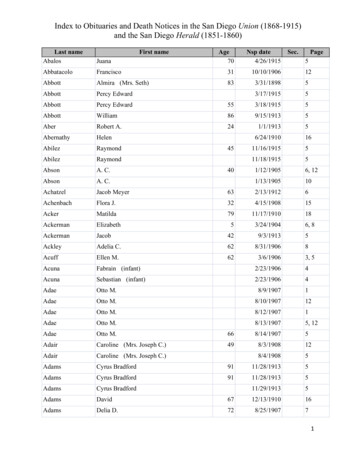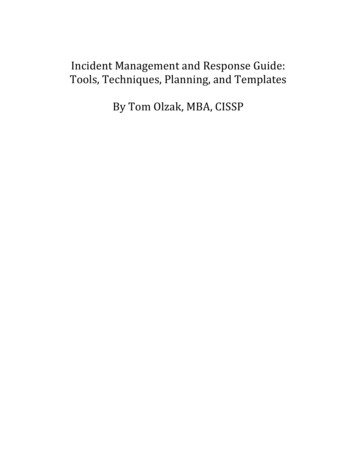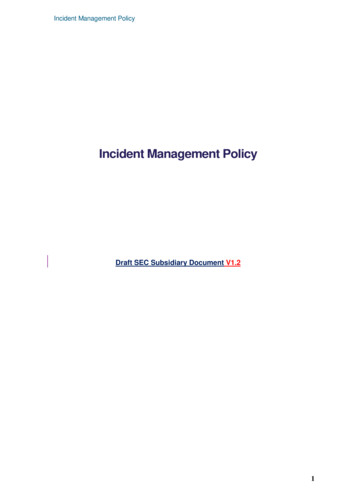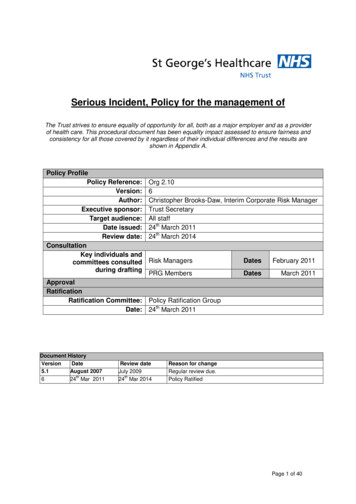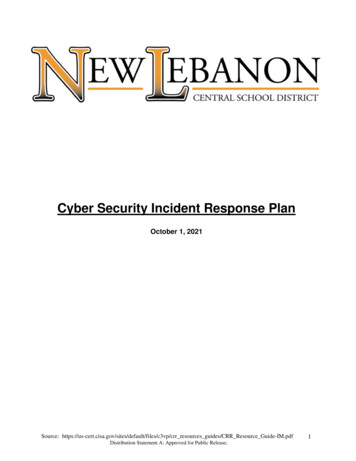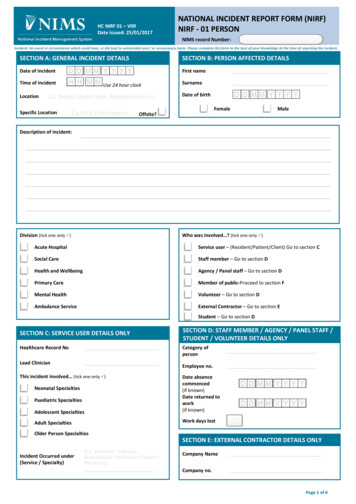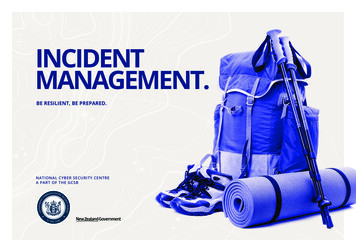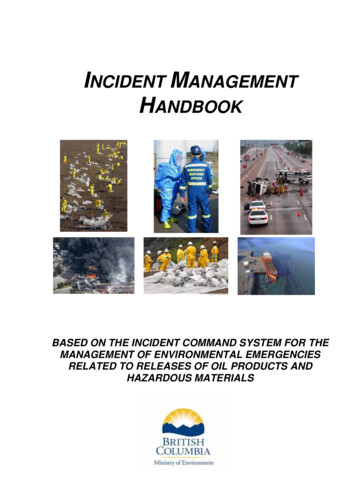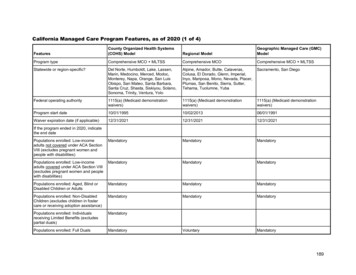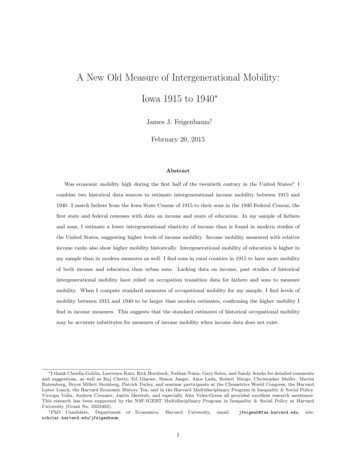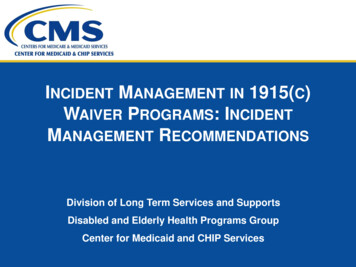
Transcription
INCIDENT MANAGEMENT IN 1915(C)WAIVER PROGRAMS: INCIDENTMANAGEMENT RECOMMENDATIONSDivision of Long Term Services and SupportsDisabled and Elderly Health Programs GroupCenter for Medicaid and CHIP Services
Training Objectives This training is part three of a three-part training series based on anational survey completed by states on incident managementsystems.– Part 1 described systems and processes implemented by the state toassist with the reporting, identification, and resolution of incidents.Available here: .pdf– Part 2 identified quality improvement activities states have implementedto assist with preventing or mitigating incidents from occurring. Availablehere: .pdf This final training will focus on CMS’ recommendations for howstates can improve their efforts in developing robust incidentmanagement systems.2
Overview of IncidentManagement
What is an Incident ManagementSystem? An “incident management system” includes all technologies andprocesses implemented within a state to manage incidents. According to the 1915(c) Technical Guide, page 225, an incidentmanagement system must be able to: Assure that reports of incidents are filed; Track that incidents are investigated in a timely fashion; and Analyze incident data and develop strategies to reduce the risk andlikelihood of the occurrence of similar incidents in the future.14
Key Elements of Incident ManagementSystems The following are six key elements that states must consider whenimplementing an effective Incident Management System:5
Overview of the IncidentManagement Survey
Survey Background7 Incident management has become a focus of the U.S. Health andHuman Services (HHS) Office of Inspector General (OIG) andGovernment Accountability Office (GAO) due to reports ofpreventable incidents that occur for individuals receiving home andcommunity-based services (HCBS). In July 2019, CMS issued a survey to 47 states requestinginformation on their approach to operating an incident managementsystem under 1915(c) HCBS waiver authority. The goal of the survey was to obtain a comprehensiveunderstanding of how states organize their incident managementsystem to best respond to, resolve, monitor, and prevent criticalincidents for their waiver programs.
Survey Methodology This survey was provided through a web-based platform. States self-reported their data and submitted surveys for eachunique incident management system. The survey consisted of 146 questions across 8 sections:1. Systems2. Reporting3. Incident Resolution4. Quality Improvement5. Collaboration6. Training7. Prevention8. Mitigation of Fraud, Waste, and Abuse (FWA)8
State Interviews CMS conducted interviews with 5 states to gain a more in-depthunderstanding of their incident management systems from October2019 to January 2020. These 5 states were selected for interviews because theydemonstrated promising practices in their survey responses. CMS developed interview questions tailored to each state’s incidentmanagement systems. Interview questions sought to clarifyresponses provided in the survey and to highlight the strengths andlessons learned of each state system.9
Overview of Survey Responses CMS received 101 survey responses, representing 101 unique incidentmanagement systems across 45 states and 237 waivers.– To account for the varying systems, states submitted a unique surveyresponse for each incident management system in their state. As a result,states often submitted multiple surveys. Findings are presented in terms of numbers of unique state systems tomirror the structure of survey responses.Table 1: General Survey Results10
Waiver Populations States often develop differing systems and processes in response tovarying waiver program design and population needs.– Example: One state operates two incident management systems withone pertaining to AD waivers and the other pertaining to ID/DD waivers.This state reported that certification and licensure is different for variousprovider types. Therefore, referrals and investigations are handleddifferently for different waiver recipient populations. 62 of 101 systems (61 percent) serve one distinct waiver population.Table 2: Breakdown of Waiver Populations Served*Population1.2.3.4.# of Systems% of SystemsAged or Disabled, or Both – General1Aged or Disabled, or Both – Specific RecognizedSubgroups25251%4141%Intellectual Disability or Developmental Disability, or Both35453%Mental Illness499%This includes: Aged, Disabled (Physical), Disabled (Other)This includes: Brain Injury, HIV/AIDS, Medically Fragile, Technology DependentThis includes: Autism, Developmental Disability, Intellectual DisabilityThis includes: Mental Illness, Emotional Disability11 *Note: States had the option of selecting multiple populations. As a result, total response counts do not sum up to 101 systems.
Recommendations based onFindings from the IncidentManagement Survey
Overview of Findings States have adopted different technical and administrative strategiesto assist with incident management.– Findings from the survey and state interviews demonstrate that stateshave attempted to identify and implement solutions in response tovarying priorities, whether legislative or based on state populationneeds. States with the most advanced incident management systemsconsider incident management as a cohesive system rather thansiloed processes and activities aimed towards managing incidents.– Results from the survey and state interviews clearly demonstrate thatdifferent variables (people, process, and technology) impact thesuccess of incident management.13
Incident Management Requires Coordinationof People, Processes, and Technology14 These variables work in conjunction with one another and share equalresponsibility for the success of the incident management system. For example, the impact of a strong technology platform is limited ifincidents are not adequately defined or stakeholders do not collaborate.
Recommendation 1: States could benefitfrom establishing and uniformly applying aconsistent definition of critical incidents forwaiver populations within the state.
Definitions of Critical Incidents VaryAcross and Within StatesThere is no standardized, federally defined term for “critical incident”that outlines the scope of reportable incidents. This leads to variation across states and across programs within thesame state. Unique definitions are used within states across different systems. Onesurveyed state operated four systems with four different definitions ofcritical incidents.Table 3: Example of Differing Definitions of Critical Incidents Within a State16System 1System 2System 3System 4 Abuse resulting in ERvisit or physical injury Neglect resulting inER visit or physicalinjury Exploitation resultingin ER visit or physicalinjury Accidental/UnexpectedDeath Other:o Alleged rapeo Fireo Sprinkler pipe breako Floodo Extended utility ormechanical outage Abuse resulting in ERvisit Neglect resulting in ERvisit or physical injury Exploitation resultingin ER visit or physicalinjury Accidental/Unexpecteddeath Othero APS establishedcategories ofpriority based onpossibility ofharm
Identifying Incidents by Risk AllowsStates to Prioritize InvestigationsA majority of state systems do not conduct investigations on all reportedincidents. Survey results illustrate that 59 of 101 systems (58 percent) do not performinvestigations on all reported incidents.Figure 1: Investigations on Reported Incidents17 States reported that they relied on the nature and severity of theincident to determine which incidents to investigate. Not all incidents require or would benefit from an investigation.However, incidents identified as critical should trigger an investigation.
Unclear Definitions Can Hinder Systems’Ability to Respond to IncidentsWithout clear definitions states may overlook systemic problems. The GAO, in their 2018 report on Medicaid Assisted Living Services, found that“Without clear instructions as to what states must report, states’ annual reportsmay not identify deficiencies with states’ HCBS waiver programs that may affectthe health and welfare of beneficiaries.” 2 This finding from the GAO is also supported by findings from the survey.– Example 1: Lack of Differentiation One state reports on all incidents of hospitalizations and ER visits, due to a lackof clarity about whether an incident is considered critical or non-critical. Manywaiver participants experience chronic health issues, resulting in overreporting ofhospitalizations and ER visits, even if not tied to an incident. This is a burden on state resources and often misdirects states from triaging andinvestigating the most urgent incidents.– Example 2: Lack of Specificity A state system reported that design issues and a lack of a clear definition led to amajority of incidents categorized as “Other”, which has limited the state’s ability toidentify system level patterns and trends.18
Standardized Definitions ReduceAmbiguity and OverreportingSeveral surveys noted that the success of their incidentmanagement system is dependent on the identification andreporting of incidents. To reduce redundancies and potential gaps in what types ofincidents are reported, states should begin to clearly define incidentsand consistently apply this definition within their incidentmanagement system across their waiver programs. A standardized definition reduces ambiguity with regards to whatqualifies as an incident and leads to quicker identification ofincidents throughout all levels of the care delivery system.19
States Could Benefit from Applying aStandardized Definition of Critical IncidentsStates should include, at a minimum, the following incident types in theirdefinition of critical incidents: Accidental/Unexpected Death Broadly defined allegations of physical, psychological, emotional, verbal andsexual abuse, neglect, and exploitation (ANE) 3States commonly included the following “Other” definitions in theirsurvey responses, which we also recommend considering: Fiscal exploitation resulting or not resulting in law enforcement or intervention Medication error Use of restraints Mental health treatment/ psychological injury Criminal activity/ law enforcement intervention Missing person/elopement General risk to health and welfare20
Critical Incident Definitions Codified InState Law Can Enforce AccountabilityStates should codify definitions in state law or regulation toenforce accountability within an incident management system. Definitions outlined in state law promote transparency for allindividuals involved with incident management, includingbeneficiaries, providers, and state staff.– One interviewed state emphasized this as a best practice, since allstakeholders are aware of what they need to report.– One surveyed state cited a lack of an explicit statutory obligation as aweakness and limitation of their system as it has hindered providers’understanding of which incidents need to be reported.21
Recommendation 2: There is anopportunity for State Medicaid Agencies(SMAs) to establish stronger oversight oftheir systems.
Multiple Entities Are Often ResponsibleIn The Incident Management ProcessIncident management is often the responsibility of multipleentities within the state. These entities include state agencies involved in the delivery ofMedicaid services, Program Integrity staff, state AttorneyGeneral/Inspector General, and protective services agencies. States report that, on average, 2 to 3 entities are responsible for keyincident management activities, such as contacting individuals aboutthe incident report, referring incidents to additional investigativeauthorities, or following-up with individuals.23
Shared Responsibility Across AgenciesCan Result In Coordination ChallengesShared responsibility across agencies often results in disjointedcommunications across different parties. Surveys noted communication challenges, especially wheninvestigations are not conducted by the oversight agency.– Survey respondents stated that protective services programs do notalways disclose investigation outcomes to the oversight agency, whichcreates information gaps and hinders follow-up efforts. Shared responsibilities without a formal structure for coordinationcan result in duplicated efforts and inefficient use of state resources.– One surveyed state reported that because its Division of Medicaid andDepartment of Human Services are separate agencies, case managersand providers are required to separately report incidents in bothagencies resulting in duplication of effort.24
States Could Benefit From Establishing aGovernance Structure for Managing IncidentsStates could benefit from establishing a governance structure tominimize confusion regarding roles and responsibilities of theincident management process. Agencies involved in the incident management process need tocollaboratively develop solutions and strategies to support managingincidents. Several interviewed states emphasized a need for a champion thatprioritizes information sharing across agencies to support theincident management system.– One state described how the State Medicaid Agency provides oversightof the incident management system and partners with the Departmentof Intellectual and Developmental Disabilities to analyze incident dataand respond with interventions.25
There is Potential for SMAs to EstablishStronger Oversight of Their SystemsAs the ultimate authority responsible for 1915(c) waiver programs,the SMA is uniquely positioned to provide authoritative supportregarding the incident management system. The SMA is accountable to CMS for implementing an effectivesystem that assures waiver participant health and welfare. SMAs should ensure that incident management systems areoperating effectively, regardless of whether they directly managethese systems or delegate management responsibility to operatingagencies. SMAs should maximize their partnerships with the agencies thatoperate, manage, and implement their incident managementsystems.26
Recommendation 3: States can benefitfrom designing their incident managementsystems on an electronic platform thatcentralizes the reporting, tracking, andsharing of incidents.
States Can Benefit From Designing Systemson a Web- or Cloud-based PlatformThe use of web- or cloud-based systems is a powerful tool forstates looking to improve their incident management system. Reporting, tracking, and sharing data are foundational elements ofthe incident management process. Technology supports real-time data reporting, tracking, and sharing.Web- or cloud-based systems streamline and provide centrality tothe incident management process in the state.28
Web- or Cloud-based PlatformsSupport Greater Access to DataElectronic systems support data access for many stakeholders,ranging from the reporter to state agency staff. Typically, more than one entity or individual is responsible forincident management. State systems that support electronic functionalities are more likelyto provide access to more than one stakeholder.– States that reported using no electronic capabilities usually limitedsystem access to their OAs and/or their SMAs.– Systems that support electronic functionalities provide access toapproximately 4 stakeholders. Manual processes or Microsoft tools often limit the use of theinformation to one individual at a time, whereas electronic systemsallow for multiple individuals to access the system concurrently.29
Web- or Cloud-based Platforms SupportContinual Data Aggregation and AnalysisWeb- or cloud-based platforms provide a way for states to captureinformation from a variety of sources in one location. Consolidating multiple databases and reports in a central locationcan help maintain data integrity and streamline data aggregation,compilation, and analysis. Incidents, once reported and recorded in an electronic system, canbe continually tracked and used for trend analysis.– Of the 78 survey responses indicating the use of trending capabilities,48 (62 percent) are web- or cloud-based and 30 (38 percent) are nonweb- or cloud-based.30
Web- or Cloud-based Platforms FacilitateData Sharing Across Different SystemsWeb- or cloud-based systems can support interoperability. Incidents are nuanced and states can benefit from relatedinformation that may be available outside of what is collected in theinitial incident report.– One state expressed that interoperability between the casemanagement and incident management systems helped inform casemanagers of any potential investigations when delivering care.– One interviewed state is considering developing an integrated incidentmanagement and electronic visit verification (EVV) system with adashboard supporting real-time information that investigators canaccess. Interoperability is an area states can begin to further develop.– Survey results indicate that only 33 of 101 systems (33 percent) supportelectronic interoperability with other systems.31
Effective Systems are Updated BasedOn Changing NeedsStates can adapt web- or cloud-based systems to meet theirchanging needs. Incident management is an evolving and often iterative process. Many states reported that since implementing an incidentmanagement system, they are continually updating and makingrevisions to address feedback provided from key stakeholders, datafrom trend analysis, and new legislative requirements.32
Legacy Systems and Cost Can Be Barriers toImplementing Web- or Cloud-based SystemsStates may encounter challenges when implementing web- orcloud-based systems. Older legacy systems struggle to adapt to the changing landscape ofincident management and cannot develop necessary trend reports. States must factor the costs associated with system implementationas well as ongoing maintenance and/or updates to functionality.– Leverage federal participation, such Health Information Technology forEconomic and Clinical Health (HITECH) funding made available byCMS through Federal Fiscal Year 2021 via the APD process describedin 42 CFR 495. 4– One interviewed state received a grant from the Department of Justiceto fund the development of an online reporting system to support onlinereporting capabilities aimed to prevent elder abuse.33
Recommendation 4: States should ensurea comprehensive Quality ImprovementStrategy (QIS) that maximizes the use ofavailable data to support systemicinterventions.
States Can Benefit From Maximizingthe Use of Available DataStrong incident management systems require a comprehensive QISthat maximizes the use of available data and supports thedevelopment of systemic interventions. Alternative datasets such asclaims data and hospitaladmissions can be helpful inidentifying unreportedinstances of abuse, neglect,and exploitation (ANE).– 27 of 101 systems (27 percent)conduct a cross checkbetween ER admission dataand HCBS case managementdata.– Only 8 of 101 systems (8percent) integrate FWAprovider lists with ANEproviders.35Figure 2: Crosschecks Between ERAdmission Data and HCBS DataFigure 3: Integrated FWA and ANEProvider Lists
Trend Reports Can Inform InterventionDecisions and Track Their EffectivenessData-driven analyses can provide the necessary tools for identifying,understanding, and addressing systemic problems. Survey findings show that incident management systems use data todevelop trend reports for the state.– 97 of 101 systems (96 percent) create at least one trend report based oncritical incident data.– However, only 44 of 101 systems (43 percent) have implemented asystemic or operational intervention in response to trend reports.Figure 4: Interventions Implemented as a Result of Trend Reports36
Conducting Multi-Level Analyses Can HelpStates Develop More Targeted InterventionsTrends identified at the local or regional level may not applyuniversally to all areas in the state. States may need to tailor prevention tactics on a more regionalbasis, as certain state-wide interventions may not be relevant whentackling issues at a local level.– One interviewed state identified a spike in the number of reportedincidents and isolated this increase to one region, with one provider,impacting three individuals within a specific agency. Rather than a statewide intervention, the state focused on solutions for the three individualsimpacted.37
States Must Critically Evaluate TrendsWhen Monitoring Intervention EfficacyStates that perform a multi-level review of data may find that anincrease in incidents does not necessarily indicate a failure ofpreventive efforts implemented in the state. An interviewed state reported developing a health alert andadditional trainings in response to a surge in number of physicalabuse incidents. Following the intervention, the state saw a continued rise in abusereports. The state determined that a rise in incidents could beattributed to an increased understanding of reporting requirementsin response to the trainings. States need to be careful about drawing conclusions based solelyon numbers of reported incidents – increases could be an indicatorthat there is additional awareness throughout all levels of thesystem.38
States’ Prevention Tactics Should Align WithTheir Greater Quality Goals and ObjectivesIncident management systems should consider how their preventiontactics fit in relation to the state’s greater quality goals and objectives. States should implement data-drivenprevention tactics, such asperformance measures and trainings.Of the 101 systems surveyed:Figure 5: Implementing Trainingsin Response to Trend Reports– 61 systems (60 percent) reportedcreating new trainings based onfindings from trend reports.– 47 systems (47 percent) reportedimplementing performance measuresin response to trend reports. 39These findings provide insight intohow state systems are using incidentdata trends to create strategies thatimprove the delivery of care andreduce unnecessary incidents fromoccurring.Figure 6: Implementing Performance Measuresin Response to Trend Reports
Outcome-Based PerformanceMeasures for Health and Welfare States may use outcome-based performance measures to track the rate, prevalence,and/or occurrence of unfavorable participant outcomes. Outcome-based performance measures found in Appendix G largely fall in one of twocategories:– Incident Prevalence – quantify the occurrence of specific incidents.– Survey or Interview Result – quantify the results of surveys or interviews.Table 4: Examples of Outcome-Based Performance MeasuresSub-assurancesG-i40Examples of Outcome-Based Performance Measures Number and percent of critical incidents requiring investigation, by typeNumber and percent of deaths reported by providersNumber and percent of satisfaction survey respondents who reported that someone hitor hurt them physicallyG-ii The percentage of critical incidents where the root cause was identified. Number and percent of licensed providers cited for medication errors.G-iii Percentage of restrictive interventions resulting in medical treatment.G-iv Number and percent of those who responded that their overall health is good, very goodor excellent on the survey
States Should Consider PreventionTactics that Target Unreported Incidents Some state systems reported implementing policies and processes toassist in identifying unreported incidents.Figure 7: Identifying Unreported Incidents States should further the adoption of prevention tactics that focus onidentifying unreported incidents. These include:– Additional training sessions– Additional check-ins or home visits by providers/case managers– Review of service plans– Creation of lists identifying individuals with higher risk of incidents41
Recommendation 5: States can betterreinforce interventions and strategies usedto manage incidents through thedevelopment of a robust training strategy.
Trainings Can Be Effective Tools InIdentifying IncidentsSurvey findings highlight that many states are using trainings toeducate key stakeholders regarding key functions of the incidentprocess. 91 of the 101 systems (90 percent) provide initial or ongoingtrainings to at least one of the following stakeholders: providers,state staff, investigative staff, waiver participants, individuals withself-directed services, or family/unpaid caregivers. 57 of 101 systems (56 percent) reported providing trainings to two ormore of the stakeholders identified above.43
Trainings Can Be Effective Tools InPreventing Incidents Providers and case managersregularly interact withparticipants and can be trainedto detect potential signs ofabuse, neglect, andexploitation.– 62 of 101 systems (61 percent)provide training highlighting riskfactors that help identifypotential occurrences ofincidents.– 56 of 101 systems (55 percent)provide training highlightingsigns/symptoms that couldindicate the potentialoccurrence of incidents.Examples include radialfractures, visits to primary careproviders, etc.44Figure 8: Trainings on Risk FactorsFigure 9: Trainings on Signs/Symptoms of Incidents
Some States Do Not Consistently OfferTrainings to All StakeholdersStates would benefit from developing a training strategy that is consistentlyapplied across stakeholders. Family/unpaid caregivers and waiver participants are less likely to receiveroutine or standard trainings. States provided ongoing trainings to providers in 79 of 101 systems (78percent). In comparison, states provided ongoing trainings to waiverparticipants in 47 of 101 systems (47 percent).*Figure 10: Ongoing Training Provided by the State*** Note: Counts are inclusive of states that selected “Applies to All”.45 **Note: For this question, states had the option of selecting multiple answer choices. As a result, total response counts do not sum up to 101 systems.
Trainings Should Be Accessible To AllIndividuals Involved In Incident ManagementStates should support the availability and accessibility of training materials toall impacted stakeholders. Training materials are often more readily available to providers and state staff(81 of 101 and 71 of 101 systems, respectively) than to waiver participants orfamily/unpaid caregivers (53 of 101 and 48 of 101 systems, respectively). Only 13 of 101 systems (13 percent) reported having trainings readily availablefor individuals with self-directed services.Figure 11: Stakeholders’ Access to Training Materials*** Note: Counts are inclusive of states that selected “Applies to All”.46 **Note: For this question, states had the option of selecting multiple answer choices. As a result, total response counts do not sum up to 101 systems.
States Should Administer TrainingsThrough a Variety of MethodsStates should administer trainings through a multitude ofplatforms to reach all individuals within their incidentmanagement systems. States should continue to adopt a variety of methods for howtraining is administered, including in-person training, self-paced webtraining, and web-based live training. State systems benefit from exploring new platforms to widen accessto their training materials.– For example, one state adopted social media campaigns on key topics,distributed through a variety of channels such as Facebook, Twitter, andInstagram. The state also created a YouTube channel which housesshort health and welfare trainings for providers and the general public.– Social media and alerts efficiently deliver information regarding incidentmanagement training and prevention to a broader population.47
States Can Use Data to DriveTraining Initiatives States should create trainings based on issues identified throughdata analysis. One of the ways states can do this is through the useof alerts to providers, individuals, and family/unpaid caregivers.– Once trends highlight an area of concern, states can create an alert viathe incident management system, case management system, or socialmedia.– Alerts spread awareness of identified issues and inform stakeholders onproactive measures that can mitigate or support the monitoring of theseissues.48
Conclusion Critical incident management is a priority for states. States adopt different systems that are unique to their needs andobjectives, and often states support multiple incident systems toreflect the nuanced differences in the populations served. Such differences underscore the complexity of incident managementand highlight the potential challenges states have in making surethat incidents are adequately reported, tracked, investigated, andanalyzed. Incident management is a continually evolving process,necessitating upgrades to technologies, clarification of roles orresponsibilities, and review of challenges and/or best practices.49
References1. U.S. Department of Health and Human Services, Centers for Medicare &Medicaid Services, Instructions, Technical Guide and Review Criteria (January2019), Available online: https://wms-mmdl.cms.gov/WMS/faces/portal.jsp2. Government Accountability Office. “Medicaid assisted living services – improvedfederal oversight of beneficiary health and welfare is needed.” January 2018.Available online: https://www.gao.gov/assets/690/689302.pdf3. U.S. Department of Health and Human Services, Centers for Medicare &Medicaid Services, CMCS Informational Bulletin: Health and Welfare of Homeand Community Based Services (HCBS) Waiver Recipients (June 2018),Available online: wnloads/cib062818.pdf4. U.S. Department of Health and Human Services, Centers for Medicare &Medicaid Services, Availability of HITECH Administrative Matching Funds toHelp Professionals and Hospitals Eligible f
incident management process. Agencies involved in the incident management process need to collaboratively develop solutions and strategies to support managing incidents. Several interviewed states emphasized a need for a champion that prioritizes information sharing across agencies to support the incident management system.
